Aardvark Rockets American Dream (2.6")
Aardvark Rockets - American Dream (2.6") {Kit}
Contributed by Nick Esselman
| Manufacturer: | Aardvark Rockets |
![[Picture]](/images/archive/images/ratings/rating_aard_american_dream.gif) (06/23/01) I was very pleased to get a pre-release of the first rocket of the
new Nebula Line from Aardvark Rockets, the 2.6" American Dream. It is a
nice looking rocket with a "50's Style" look. That look comes
primarily from the rounded fins. This does make this rocket unique from
traditional trapezodial or elliptical. It is designed to fly on 29mm motors
with recommended motors ranging from an F37 to H120 (yes, I said H). For me,
the guy that enjoys watching the whole flight, I will utilize a 24mm adaptor
and fly it on E and F's and will then go to the 29mm EconoJet F's and G's for a
thrill. No H's will fly in this one...although I do own a 29-180 RMS
case....hmmmm!
(06/23/01) I was very pleased to get a pre-release of the first rocket of the
new Nebula Line from Aardvark Rockets, the 2.6" American Dream. It is a
nice looking rocket with a "50's Style" look. That look comes
primarily from the rounded fins. This does make this rocket unique from
traditional trapezodial or elliptical. It is designed to fly on 29mm motors
with recommended motors ranging from an F37 to H120 (yes, I said H). For me,
the guy that enjoys watching the whole flight, I will utilize a 24mm adaptor
and fly it on E and F's and will then go to the 29mm EconoJet F's and G's for a
thrill. No H's will fly in this one...although I do own a 29-180 RMS
case....hmmmm!
I also did a comparison on Mid to High Power Starter Rockets - See Here.
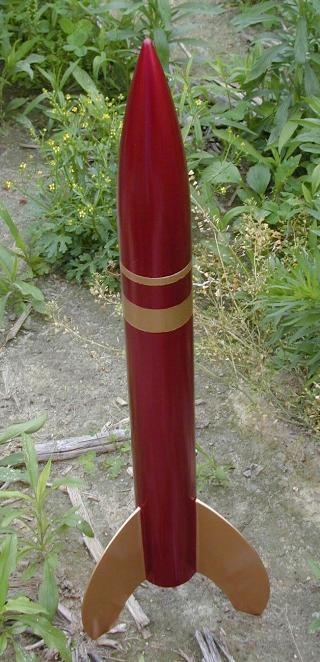 The
2.6" American Dream is the baby of American Dream rockets that include
family members sporting 4", 6" and 7.6" mid-sections
(diameters). There are some photos of these bigger boys on Aardvark's
site. For me, the 2.6" is just right.
The
2.6" American Dream is the baby of American Dream rockets that include
family members sporting 4", 6" and 7.6" mid-sections
(diameters). There are some photos of these bigger boys on Aardvark's
site. For me, the 2.6" is just right.
The rocket was bagged and packaged in a nice shipping box with a hinge-like lid. The fins were double bagged, which I assume was to prevent moisture from getting to them and possibly warping them. It succeeded if that was the plan.
The kit includes a pre-slotted 2.6" diameter body tube. The wall of this tube is 1/16" thick and to put that in perspective it is 2x the thickness of an Estes Fat Boy tube. It uses three (3) 1/4" thick plywood centering rings which also increase the sturdiness of the rocket. The fins are also 1/4" thick plywood and have tabs for through-the-wall mount and reach the 29mm motor tube. It comes with a plastic nose cone and a 3/8" Launch Lug. Also included is a 1/8" x 2" Eye-screw with hardware for attaching the shock cord to the upper centering ring. You can purchase the American Dream with or without a shock cord and parachute. There was nearly 10 feet of 3/8" wide, flat Kevlar® shock cord and a 24" nylon parachute that came with my kit.
CONSTRUCTION:
There are four (4) pages of instructions with the kit, with two being dedicated to written assembly instructions. The other two provide painting scheme with Red, White and Blue to support the rocket's name, motor recommendations, recommended supplies/tools and parts checklist. There is also an page identifying the CP which is a nice touch.
The written assembly instructions do not include illustrations and therefore gear the kit toward someone that has some experience. They attempt to show the sequential process by indicating what previous steps need to be complete prior and what tools and parts are needed for the current step. I didn't find any real value in this, however, I can image that this format would be helpful for more complicated kits and ones that could be assembled in various stages while other sections dry.
Aardvark recommends the use of fast and medium cure epoxy, but I choose to use ProBond glue for assembly. I used it for the entire build including the initial fillet. I then filled over the top with epoxy which is a technique that I like because of how ProBond dries and fills the seam between the fins and the slots. The only other place I used epoxy was on the aft centering ring and the exposed inside walls of the body tube around the motor mount. (additional comments about ProBond glue)
A couple of points in the instructions; in Step One it indicates that you should drill a 1/4" hole into the upper centering ring, but the one in my kit already had a hole. In Step Two it says to secure the eye bold eye facing out. My initial thought was that this should say "up", but now thinking about it Aardvark meant "out" to ensure that the eye is looking at the motor mount and the body tube wall (parallel to both).
Also on Step Two, you are instructed to "secure the mid centering ring just forward of the forward end of the fin slots in the airframe". I found there were two ways to figure this out so that you could mark the motor tube. First you could measure from the bottom of the body tube to the top of one slit in the body tube and then match that measurement on the motor tube, or you could place the motor tube without any centering rings into the body tube, keeping the bottoms even and mark the motor tube using the opening from the slit. I used the latter method, but regardless I think it needs to be marked.
When mounting the fins, I noticed that they reached all the way to the 29mm motor tube, which is key for strength, but that the tab may have been 1/16" too long because my fins didn't sit flush on the main body tube where the fins over-lapped. I filled this space with ProBond glue and am sure this is not a problem.
Assembly is a breeze and the techniques provided for make a solid rocket. First there is a 9" 29mm motor tube that is strengthened by the three 1/4" thick centering rings. Then the three 1/4" thick fins are mounted through-the-wall and onto the motor tube and up against two of the centering rings. Very strong.
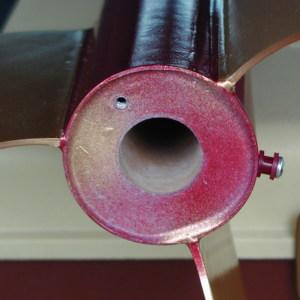 The provided 1/4"
centering rings are also excellent because even though the kit didn't include
any motor retention hardware, I added a T-nut. With the 1/4" centering
rings it is flush to the surface. With the usual and common 1/8" thick
centering rings the T-nut would stick up!
The provided 1/4"
centering rings are also excellent because even though the kit didn't include
any motor retention hardware, I added a T-nut. With the 1/4" centering
rings it is flush to the surface. With the usual and common 1/8" thick
centering rings the T-nut would stick up!
I didn't use the provided Launch Lug and instead substituted with a couple of Matt's Rail Buttons. I have been putting both lugs and rail buttons on since I purchased my Blacksky Rail, but this time I only installed the buttons. Notice how nice the red ones match the finish of my kit?
Aardvark then says to paint your rocket using the drawing as a guide, or utilize your own creativity. I didn't utilize the Red, White and Blue paint scheme and went with my own. I also used my standard method for finishing Kraft paper tubes and also for finishing plastic nose cones. I spent a bit of extra time on this and it came out very nice (I and the RSO for its first launch both thought so at least). I used Dupli-Color Maroon for the body and ColorWorks by Krylon for the Gold Fins and Rings and then I used Krylon Clear over everything to finish it off.
Overall, for CONSTRUCTION I would rate this kit 4 points. If the instructions had illustrations then this kit could reach a larger selection of modelers. Outside of that, motor retention and decals would drive this kit to perfect . . . understanding that both of those items are not too common with medium and high power kits.
FLIGHT/RECOVERY:
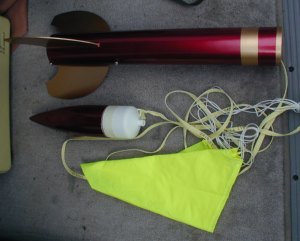
Aardvark provides the following for recommended motors:
- F37W-6 = 636 feet
- F40-10 = 1322 feet
- F60-10 = 1442 feet
- G40-13 = 2193 feet
- G80-10 - 2203 feet
- H120-14 = 3604 feet
- H97-altimeter = 3156 feet
- G33-altimeter = 1635 feet
These altitudes are based on a finished rocket weighing in at 20.7 ounces. My finished kit weighed in at 15.25 ounces and even after adding the 24mm motor adaptor was only 15.75 ounces. With the finished weight of my rocket I would get about 400 feet more altitude on a G40.
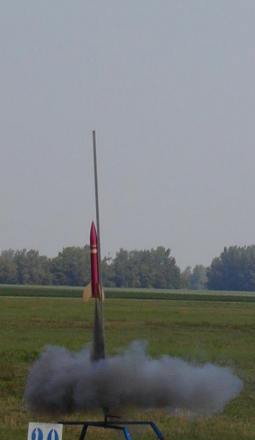
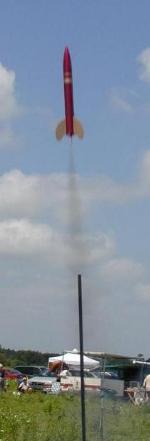 As mentioned I added a
24mm adaptor so I could fly it using my 24mm RMS system. The first flight was
on an E28-7 that I had been getting short delays on from the package of
3 reloads. I had hoped for a short delay and got it. In fact is was quite short
as the rocket was still heading upward. Upon ejection the nose cone separated
but the parachute was stuck in the rocket inside a Large Heat Shield from Pratt
Hobbies. I should have know about the "friction" aspect on the Heat
Shield as I have had this once before. The rocket hit the ground and picked up
a little mud but no damage.
As mentioned I added a
24mm adaptor so I could fly it using my 24mm RMS system. The first flight was
on an E28-7 that I had been getting short delays on from the package of
3 reloads. I had hoped for a short delay and got it. In fact is was quite short
as the rocket was still heading upward. Upon ejection the nose cone separated
but the parachute was stuck in the rocket inside a Large Heat Shield from Pratt
Hobbies. I should have know about the "friction" aspect on the Heat
Shield as I have had this once before. The rocket hit the ground and picked up
a little mud but no damage.
The second flight was on a 24mm F39 (left) and according to RockSim this would give me just about 1000 feet. I used a delay of 9 which was about a second too long as it started heading down at ejection. This time I packed the Heat Shield by itself (like wadding) and didn't wrap the parachute in it. It deployed and fell at a nice rate on the 24" parachute.
I was able to get out and fly a 3rd flight on an EconoJet F20 the following weekend and wow!, this is a nice rocket/motor combination. You get the ROAR from the EconoJet's, the flame from the 29mm "F" (as opposed to the 24mm E and F as pictured above), and altitudes that are not so high that you can't see the whole flight. Ejection on the F20-7 was about 1 second too long, but fine, and descent was excellent. Truly an enjoyable flight. Definitely plan on flying on an EconoJet.
After another F39 flight, I was able to fly it at NARAM-43 on an F22 (right). Nail biting as is seemed to have the longest delay, but finally it opened and was recovered without damage.
For FLIGHT/RECOVERY, I would rate this kit 4 ½ points. I think the kit should come with a 24mm adaptor because of the high altitudes that are achieved on 29mm motors. By doing so, the kit's versatility for high fliers to small fields would be expanded. The Kevlar® shock cord is great and the parachute is sized right. It also flies straight and stable.
Overall, the 2.6" American Dream is a solid rocket and a solid flier. I didn't test the altitude capability but it's weight and size make it a nice rocket to have in my collection. I will be doing a lot of flights on this one using the 24mm adaptor and I'm sure it will continue to stand up to less than perfect flights too! Quality components with the option of purchasing a recovery system bodes well for the kit. As for looks, it is certainly different from your typical 3FNC rockets out there so that only adds to its charm. I give the kit an OVERALL rating of 4 ½ points.
 |
 |